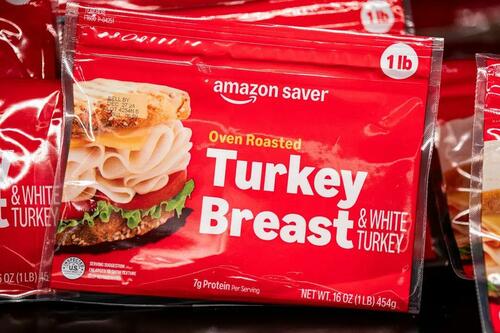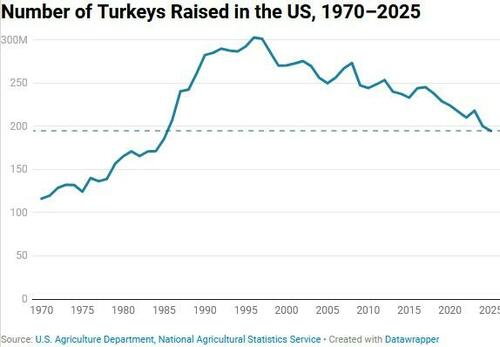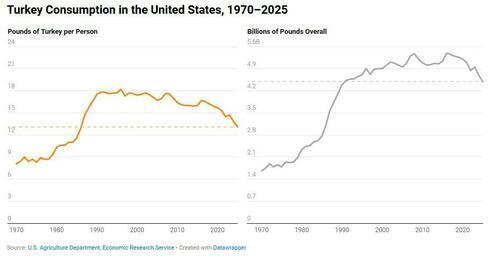In Charts: The Rise And Fall Of The Thanksgiving Turkey
Authored by Sylvia Xu via The Epoch Times (emphasis ours),
Americans will eat nearly 30 million turkeys this Thanksgiving, the National Turkey Federation estimates.

That’s almost as many turkeys as there are people in Texas, the country’s second most populous state.
Although turkey continues to take center stage on the Thanksgiving table, American turkey farmers are challenged this holiday season by a drop in demand, accompanied by ongoing outbreaks of bird flu, which disrupts supplies, drives up prices, and threatens farm livelihoods.
Rise and Fall of Turkey in America
Turkey consumption in the United States has followed an arc over the past century, driven by agricultural, technological and health trends.
According to the USDA Economic Research Service, the average person in the United States ate less than three pounds of turkey a year in the 1930s and 1940s. By 1960, that number had doubled, as producers introduced specialized bird breeds that yielded more meat.
Advances in production and the introduction of processed products such as luncheon meats, ground turkey, and deli items drove turkey’s popularity in the 1980s. Marketing campaigns promoted the bird as a healthy, low-fat meat.
Annual turkey consumption rose from an average of about 10 pounds per person in 1980, to a peak of 18 pounds per person in 1996.
Since that time, however, consumers have been steadily eating less turkey. In 2025, average turkey consumption is projected to be just over 13 pounds per person, a nearly 40 year low.
In total, the USDA projects 4.5 billion pounds of turkey will be eaten in 2025—the lowest amount since 1990, according to the latest World Agricultural Supply and Demand Estimates (WASDE) report.
The USDA estimates 195 million turkeys were raised in 2025, the lowest number in 40 years. This is the second consecutive annual decline, with production falling about 3 percent from 2024 and around 11 percent from 2023.
The 30 million turkeys Americans will eat this Thanksgiving represents 15 percent of the total number of turkeys raised in the United States this year. It also represents a 35 percent drop from the 46 million turkeys consumed during the Thanksgiving holiday in 2016, according to the U.S. Department of Agriculture (USDA).
While health-conscious consumers and dieters propelled turkey’s rise, health concerns about processed foods are now one factor causing turkey consumption to drop.
Consumers are “steering a bit away from highly processed meat,” Heidi Diestel told The Epoch Times. Diestel’s family has raised turkeys in Sonora, California, for four generations.
Bird Flu
Since February 2022, highly pathogenic avian influenza (HPAI)—also known as bird flu—has resulted in the death of almost 21 million turkeys, or about one-tenth of the current U.S. turkey flock.
The wave of infections continued in November; the Animal and Plant Health Inspection Service confirmed eight turkey operations were affected in Michigan, North Dakota, and South Dakota, impacting 431,300 birds.
Farmers are also taking a hit from Avian respiratory virus, or aMPV—an upper respiratory tract viral infection that affects all types of poultry but is most harmful to turkeys.
HPAI is nearly 100 percent fatal to exposed birds, according to former National Turkey Federation chairman John Zimmerman. Although its symptoms are generally milder, aMPV is equally devastating.

In addition to the flocks impacted by HPAI, an estimated 60 percent to 80 percent of turkey flocks were affected by aMPV in 2024, according to Zimmerman, a Minnesota turkey farmer, who testified before the House Agriculture Committee in March.
The highly contagious respiratory illness is also known as turkey rhinotracheitis, or swollen head syndrome. It’s responsible for high death rates in commercial flocks and reduces egg production in breeder stock.
“Together, these two respiratory viruses have exponentially increased volatility, supply shortages and market uncertainty,” Zimmerman said.
The H5N1 strain of bird flu, present in wild birds worldwide and primarily responsible for HPAI outbreaks in U.S. domestic birds and dairy cattle, originated in Guangdong, China.
From its first outbreak in 1996, it spread across Asia to Africa, Europe, and then to the United States. The first U.S. case was detected in early 2022, according to the Centers for Disease Control and Prevention.
Known for infecting cattle and ravaging poultry flocks, the virus is also feared for its potential to infect humans. Worldwide, since 2003, more than 890 human H5N1 infections have been reported in 23 countries, according to the CDC’s September update.
In the United States, the CDC has reported 71 cases of human H5N1 infection since 2024, including one death in Louisiana in January.
On Nov. 14, Washington state’s health department confirmed the nation’s first human case of the H5N5 strain of HPAI.

Turkey Prices
The USDA recently projected that wholesale prices for frozen whole turkey hens will reach $1.32 per pound in 2025. That’s a 40 percent increase from 2024’s price of 94 cents per pound.
“The 2025 rise in price is a response to lower production with HPAI pressures combined with steady demand,” according to a report from the American Farm Bureau Federation.
Despite this year’s jump in turkey wholesale prices, economist Bernt Nelson noted in the report that “prices are still 32 percent lower than just three years ago.”
The most recent USDA Agricultural Marketing Service data show the average per-pound feature price for whole frozen turkeys decreased during the second week of November.
“It’s encouraging to see some relief in the price of turkeys, as it is typically the most expensive part of the meal,” Farm Bureau economist Faith Parum said in a Nov. 19 news release.
Total cash receipts from turkeys in 2025 are forecast at $4.8 billion in the USDA’s September projection. This represents a 30.6 percent increase over turkey receipts of $3.7 billion in 2024, yet it remains 33.3 percent lower than the peak of $7.12 billion in 2022, when the current HPAI outbreak began.
Read the rest here…
Tyler Durden
Sun, 11/23/2025 – 10:30ZeroHedge NewsRead More






 T1
T1



